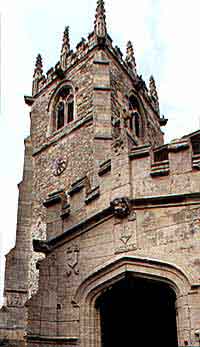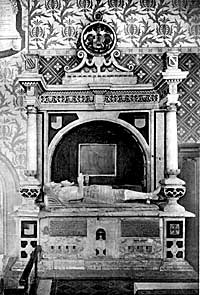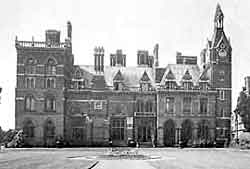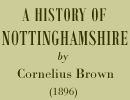< Previous | Contents | Next >
Averham and Kelham

St Michael and All Angels, Averham (A. Nicholson, 2000).
ALTHOUGH Averham is a small village possessing few inhabitants, and no place of note except its ancient church, it has associations that must always be of deep interest to Nottinghamshire people. Connected with it for many centuries has been the eminent family of Sutton, and within the walls of its sacred fane, on the edge of the silvery Trent, many distinguished men have worshipped, and some at the close of active public careers have been there consigned to rest. Before the Norman Conquest Sweyn held ‘Aygrum’ and ‘Sterthorpe,’ and after the Conqueror came upon the scene the former became the property of Gislebert Tyson. The chancel of the present church has Early English windows (date 1220 to 1300), and the tower is Perpendicular, surmounted by eight pinnacles. The masonry consists of rude courses of gray stone, and they are laid on the north side in the herring-bone style. The porch was built by Sir Thomas Sutton, who died in 1526, and his initials may be seen above one of the shields on the arch.
There are several ancient memorials to the Suttons in the church. On the south wall is a mural monument, adorned with cherubs and armorial bearings, to the memory of the Right Hon. Robert Lord Lexington, ‘descended from ye ancient family of ye Suttons.’ The inscription testifies that he was ‘a loyall subject, a lover of his country, a good Husband, Father, Friend, Landlord, Master, and Neighbour. He died October 12th, Anno Dni. 1668, in the three-score and fourteenth year of his age.’ A door in the north wall of the chancel opens into a mortuary chapel, in which other members of the Sutton family, and also some of the Chaplins, lie buried.
After the Tysons and their relatives of the name of Hose, the owner of the manor was Robert le Sauvage, in the reign of Henry III., who, being responsible for ‘a great sum,’ was pressed for payment by one Aaron, a Jew, of York. Under these circumstances he turned to an astute neighbour, Robert de Lexington (or Laxton), in this county, who, having influence at Court, no doubt rendered aid to him in a very substantial manner. John de Lexington, his brother, was appointed to try the Jews who were charged with various offences in those times of persecution, while Robert had acquired sufficient wealth to enable him to acquit Sauvage of the sum due to Aaron. In return for the relief afforded Sauvage granted to him the Manor of Aygrum. Lexington kept it until his death, which took place on May 27, 1250, and being an ecclesiastical person, and having no children, he left it to his nephew, Robert de Sutton, the son of his sister Alice, who had married Roland de Sutton. The Suttons took their surname from Sutton-on-Trent, which is only a few miles from Lexington, and like the Cromwells, who came from another of our Notts villages, they branched out into various localities, and rose to great dignities. Sir William Dugdale commences his account of the Sutton family with the following observations: ‘In the time of Queen Elizabeth, when Ambrose Dudley, Earl of Warwick, and Robert his brother, Earl of Leicester (sons to John Dudley, some time Viscount L’Isle, Earl of Warwick, and, lastly, Duke of Northumberland), powerful men in their day, did flourish, the most learned and expert genealogists of the age spared not their endeavours to magnifie this family, whence those great men did, by a younger son, derive their descent; some deducing it from Sutton, of Sutton in Holdernesse; some from the Suttons, of Sutton Madoc, in Shropshire; but others from Sutton, of Sutton-upon-Trent, near Newark, whence the Suttons of Aram (near at hand) are descended. Of which opinion was the right learned and judicious Robert Glover, then Somerset Herald, and Henry Ferrers, of Badsley Clinton, in the county of Warwick, Esq. (a person likewise much versed in those studies), all of these giving probable reasons for their various conjectures.’ Thoroton also shows in the pedigree in his history how the Suttons of Averham and the Suttons Lords of Dudley sprang from the same stock.

Tomb of Sir William Sutton (died 1607) and his wife, Susanna.
Sir William Sutton was a courtier in Queen Elizabeth’s time, and his eldest son, Robert, was the owner of Kelham and Averham when the Civil War broke out. There is a curious entry in the parish register of Averham which marks the untimely death of one of Mr. Sutton’s retainers: ‘A.D. 1618, Richard Linley, clerk to Mr. Robert Sutton, Esq., and Matthew Broumely, servant to Sir George Manners, of Haddon, Knight, each of the other in single combat slaine, were buried the twentieth day of June.’ The feud between the servants did not extend to the masters, or was speedily adjusted, for Mr. Sutton shortly afterwards married Elizabeth, daughter of this Sir George Manners.
In consequence of his adhesion to the cause of the King his estates were sequestered by Parliament, and his house at Averham burnt by the troops. He had been created Lord Lexington by Charles I., and recovered his estates on payment of a heavy fine. His son Robert was a distinguished diplomatist, and had an only son, who died at Madrid while his father was Ambassador there, and whose body, concealed in a bale of cloth, was conveyed to England and interred at Kelham. Lord Lexington died at Averham Park in 1723, and the title became extinct. His lordship devised his estates to his only daughter Bridget, Duchess of Rutland, for her life, and afterwards to her second son, Lord Robert Manners, on condition of his assuming the name and arms of Sutton. In the mortuary chapel, on the south side of the chancel at Kelham, there is a fine marble monument with the effigies of Lord Lexington and his wife, classically treated and reclining back to back. There is a lengthy inscription which mentions that the house of Sutton had given earls to Warwick and Leicester, and lords to the Barony of Dudley. A tablet in the chapel commemorates Thomas, Lord Manners, grandson of Bridget, heiress of Lord Lexington of Kelham, who, having filled successively the office of Solicitor-General to the Prince of Wales and King George III., became one of the Barons of the Exchequer, a peer of the realm, and eventually Lord High Chancellor of Ireland. He died in 1842. It is a singular fact that whilst Lord Thomas was Chancellor of Ireland, his brother, who had been Rector of Averham and Kelham, was Archbishop of Canterbury, and the Archbishop’s eldest son was Speaker of the House of Commons.

Kelham Hall, built in the 1860s, was designed by George Gilbert Scott.
In the last Lord Lexington’s time one of the principal seats of this distinguished family was at Averham Park; but this has long since disappeared, and the representative of the Suttons now resides in an elegant house on the banks of the Trent, in the adjoining parish of Kelham. In 1857 it was in process of restoration, and while the workmen were on the premises fire broke out and left it a wreck. Some five years after the fire a new Kelham Hall, of magnificent proportions, and of an architectural beauty far superior to that possessed by its predecessors, either at Kelham or Averham, was erected in the Italian style from the designs of Sir Gilbert Scott, and is justly said to be one of that architect’s most successful works. It is the residence of Mr. J. H. Manners-Sutton, J.P., and is one of the noblest of the stately homes that still grace our historic county.
